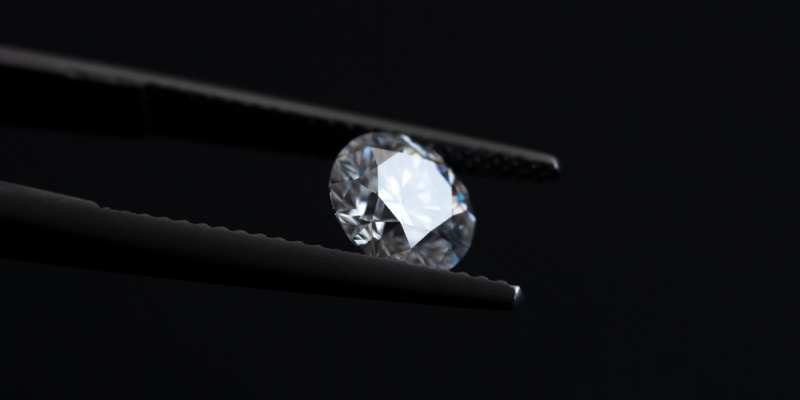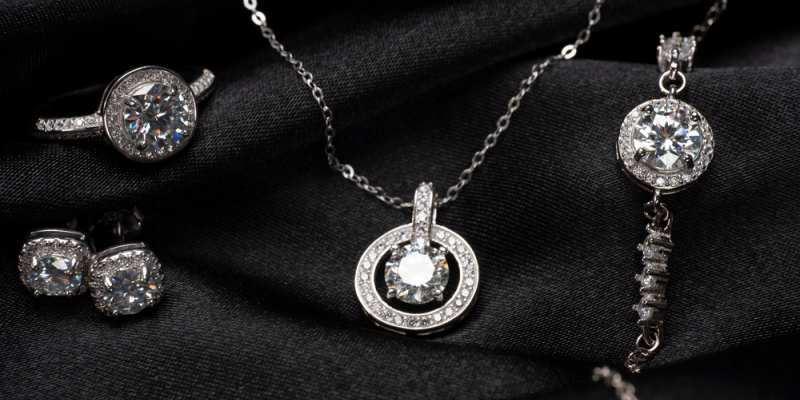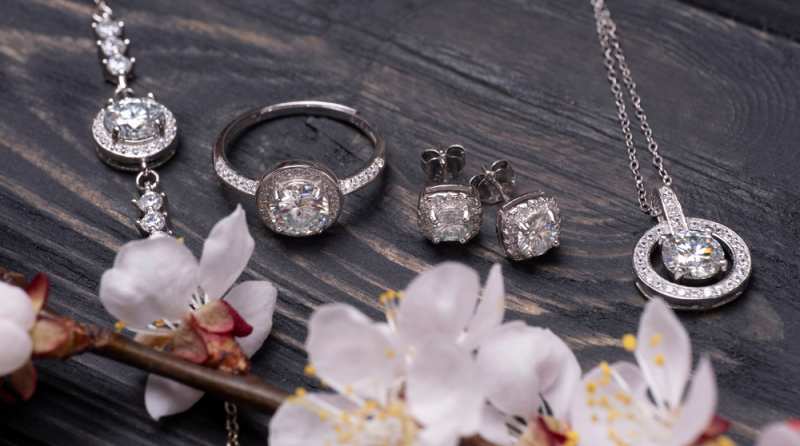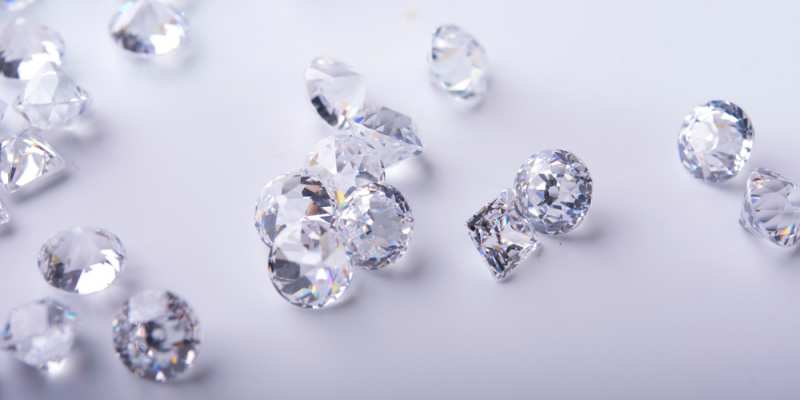Many people believe that diamonds are the brightest and most dazzling gemstones, but that’s not entirely true. There exists a wide variety of gemstones, some of which are still undiscovered, that possess a brilliance surpassing that of diamonds.
If we had to highlight one gemstone that outshines diamonds in terms of sparkle, it would be moissanite. Have you ever encountered this gemstone while browsing through jewelry stores? If not, you’re in for a treat.
As you continue reading, we will delve into the characteristics of moissanite, explore whether it truly outshines diamonds, and discover if there are other alternatives that offer that sought-after sparkle.
Keep reading to unveil the secrets!
DESIGN YOUR OWN ENGAGEMENT RING: START WITH A SETTING OR START WITH A DIAMOND. IT’S REALLY UP TO YOU!

Moissanite Sparkle
To begin with, it’s important to note that moissanite has the potential to sparkle more than a diamond, and this is largely attributed to its origin and manufacturing process. To fully understand this, let’s delve into the intriguing story behind this gemstone.
The History of Moissanite
Approximately fifty thousand years ago, a meteor struck the Earth’s surface in what is now known as Arizona, creating the famous “Meteor Crater.”
Centuries later, in 1893, a curious individual named Henri Moissan embarked on an exploration of this meteor. Through his meticulous research, Moissan discovered something remarkable about its composition – silicon carbide.
In 1905, the renowned Tiffany & Co. decided to honor the discoverer by naming this newly unearthed gemstone “moissanite.” Subsequently, the production of large moissanite crystals commenced.
Contrary to a common misconception, diamonds can originate from various sources, excluding coal. We have addressed this misconception in detail in our article titled “Does Coal Become Diamond?”
The Value of Moissanite
The value of moissanite is determined by its size, measured in carats, and the shape into which it is cut. The most prevalent cuts for moissanite include round, oval, and cushion. To provide you with a better understanding of the value, here’s a table displaying different moissanite cuts and their corresponding prices:
Round Moissanite
| Size | Carat | Price |
|---|---|---|
| 3 mm | 0.10 ct. | $40 |
| 4 mm | 0.25 ct. | $95 |
| 5 mm | 0.50 ct. | $212 |
| 6 mm | 0.75 ct. | $340 |
| 7 mm | 1.25 ct. | $570 |
Oval Moissanite
| Size | Carat | Price |
|---|---|---|
| 5×3 mm | 0.29 ct | $140 |
| 7×5 mm | 0.94 ct. | $375 |
| 9×7 mm | 2.26 ct. | $1,005 |
| 10×8 mm | 2,94 ct. | $1,400 |
Cushion Moissanite
| Size | Carat | Price |
|---|---|---|
| 5×5 mm | 0.65 ct. | $140 |
| 6×6 mm | 1.10 ct. | $275 |
| 7×7 mm | 1.80 ct. | $465 |
| 8×8 mm | 2.50. ct | $765 |
While moissanite may not reach the same price level as diamonds, it is important to note that it is not a cheap gemstone either. If you’re considering purchasing moissanite for your loved one, it is advisable to save up some funds beforehand.

Moissanite Vs. Diamonds
Differences exist between diamonds and moissanite in terms of durability, brilliance, price, and source. Let’s delve into each aspect:
Durability:
Durability refers to a gemstone’s ability to withstand pressure and scratching. Diamonds have a slight advantage in this aspect, rating 10/10 on the Mohs scale, while moissanite ranks at 9.25/10. Although moissanite’s durability is impressive, it falls short of diamond-level durability. Both gemstones are suitable for everyday wear and are popular choices for jewelry, particularly diamonds for engagement and wedding rings.
Brilliance:
Brilliance is a significant factor to consider when comparing diamonds and moissanite. Brilliance represents a gem’s inner radiance of light. Moissanite exhibits greater sparkle than diamonds, especially in larger crystals, giving off a distinctive “disco-ball light.” Diamonds also sparkle but to a lesser extent. Diamonds can display brilliance, rainbow color reflections, and light return.
Color:
Color serves as another distinguishing factor between moissanite and diamonds. While both gemstones can be colorless, it is not always the case. Roughly 90% of moissanite is colorless, with the remaining 10% displaying a slight grayish hue, still transparent. The size of a moissanite gem can affect its color perception. In contrast, diamonds can exhibit various colors, with colorless diamonds being the most valuable but can also reflect hues such as yellowish, brownish, and red.
Source:
The source of these gemstones does not present a significant difference. The first moissanite crystals were discovered as described earlier. However, advancements in technology have made lab-created moissanite more prevalent. Many people opt for lab-created gemstones due to their eco-friendly nature. Diamonds, on the other hand, have diverse sources, ranging from meteors to volcanoes. However, this does not affect their market value, as diamonds have always been and will likely remain popular. It is worth noting that diamonds can also be lab-created.
Price:
Moissanite is considerably cheaper than diamonds, despite its brighter sparkle. A 1-carat moissanite can be found for around $600-$800, while a diamond of the same size would cost around $2,000 or more. This significant price difference can heavily influence the decision of individuals working within a more restricted budget.
Will Moissanite Lose Its Shine? No!
Despite moissanite’s lower cost and slightly lower durability rating, it will not lose its sparkle over time. This gemstone is highly durable, and its reflective properties will remain intact. Both moissanite and diamonds are popular choices for engagement and wedding rings, with individuals opting for the gemstone that best suits their preferences and budget.

Facts You Didn’t Know About Moissanite
In addition to its superior sparkle, there are several intriguing facts about moissanite that may surprise you. Here are a few noteworthy ones:
Moissanite is highly heat resistant. Unlike many other gemstones, moissanite can withstand high temperatures during the shaping process. This unique characteristic allows experts to create intricate designs that may not be possible with other gemstones.
Moissanite goes by two nicknames. This remarkable gemstone is often affectionately referred to as “Stardust” and “Space Diamond,” which reflect its celestial origin and allure.
Moissanite is harder than rubies. Contrary to popular belief, moissanite is not a lightweight gemstone. In fact, it ranks higher in hardness than rubies, with a rating of 9.25 on the hardness scale.
Moissanite is rarer than diamonds. Yes, you read that right! Moissanite is one of the rarest gemstones on Earth. Originally found in meteorites, its supply is now predominantly sourced from laboratory production, making the process even more intricate.
These fascinating facts add to the allure of moissanite and highlight its distinct qualities that set it apart from other gemstones.
Other Sparkling Alternatives
Moissanite is not the only gemstone that offers a stunning sparkle. There are several other notable alternatives worth considering. Here are a few of the most famous ones:
Sapphire
Sapphires have a captivating history. Ancient Persians believed that these gems bestowed the sky with its brilliant blue hue. Throughout history, sapphires were highly sought after by great rulers and aristocracy.
Sapphires can be found in various locations worldwide, but they are often associated with Sri Lanka. In 2012, a remarkable sapphire weighing 42 kg was discovered there. One of the most renowned sapphires is The Star of India, boasting an impressive 563 carats and being over a million years old. Another notable sapphire is the one gifted by Prince Charles to Princess Diana, weighing approximately 18 carats. Passed down through generations, it now belongs to The Duchess Of Cambridge.
The price of sapphires varies based on factors such as color, size, and weight. A 1 or 2-carat sapphire typically ranges around $1000. Sapphires come in various shades, including indigo, twilight, royal, velvet, peacock, pastel, cornflower, and more.
Sphene
Although lesser-known, sphene is a significant gemstone. Known for its yellow-green color, it is also referred to as “titanite” due to its titanium content. The gemstone’s history dates back to 1787, and it was officially named “sphene” around 1801.
Sphene has a moderate hardness rating of 6.5 but possesses a captivating shine that cannot be ignored. It can be found in different parts of the world, including Brazil, Burma, Kenya, Mexico, and Sri Lanka. The value of sphene is relatively affordable, with a price of around $264 for a 1.64-carat gemstone. While yellow is the primary color, sphene can also occur in shades of green, brown, and red. Sphene gems over 5 carats showcase remarkable brilliance and can make for an accessible and dazzling gift.
Demantoid Garnet
Originally named Alexandrite, demantoid garnet was discovered in Russia’s Ural region in 1849. Initially mistaken for an emerald, it was later identified as a gemstone that occurs in a range of colors, including blue, green, red, and yellow.
Demantoid garnets larger than 1 carat are relatively rare, and finding one exceeding 2 carats is exceptionally uncommon. The market for this gemstone is not extensive, and oval is the most common shape. Throughout the centuries, demantoid garnet has been associated with healing properties. In the Medieval Ages, it was believed that turning demantoids into powder could cure fever within seconds, leading people to search far and wide for this powerful jewel.
These alternative gemstones offer unique beauty and characteristics that make them worthy contenders to moissanite and diamonds. Exploring their fascinating histories and qualities can expand the possibilities when it comes to selecting a remarkable gemstone.

Final Thoughts
It’s time to conclude our discussion on what gemstone sparkles more than a diamond. We have established that there are indeed multiple gemstones that can outshine the renowned diamond.
Among them, moissanite stands out with its exceptional brilliance. It closely resembles a diamond, making it challenging to differentiate with the naked eye. However, experts can provide detailed insights into the distinctions between these two precious stones.
What sets moissanite apart from diamonds is its rarity and pricing. Moissanite is considerably rarer than diamonds, and its production process is more complex. Conversely, diamonds command higher prices, with differences that can reach up to $500.
In addition to moissanite, there are several other valuable gemstones that possess remarkable sparkle. Examples include sapphire, sphene, and demantoid garnet. These gems offer unique qualities and add further options for those seeking shimmering and precious alternatives to diamonds.


